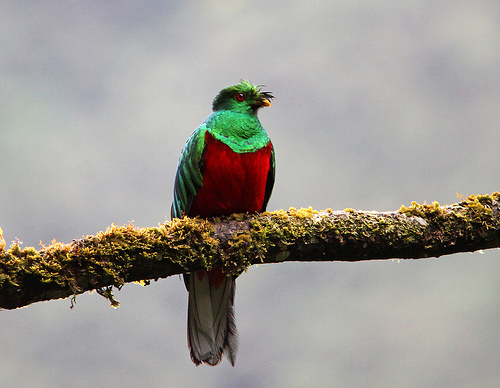Be striking like a male quetzal.
- Quetzals are tropical birds native to Central American woody and rainforest habitats.
- The scientific name of quetzals is Pharomachrus, which covers five species, and they are from the family Trogonidae, the family of trogons, although there is one more species, and it has the scientific name Euptilotis, and belongs to the same family.
- Quetzals have a diet that generally consists of fruit, such as berries, and animals of small size, like lizards, frogs and insects.
- Male quetzals have brightly coloured luminous feathers, that are mostly green and red, with an orange to yellow crest, while females generally have duller colours with the addition of brown or grey.
- Quetzals grow to be around 32 to 40.5 centimetres (12.6 to 16 inches) in height, and they generally weigh between 200 to 225 grams (7 to 8 ounces).
Quetzal
Image courtesy of vil.sandi/Flickr
- Quetzals have trouble walking on their unstable feet, that are designed for perching in the heights of trees, as they have two toes facing backwards, and the other two forwards.
- The tail of quetzals consists of two feathers that can be between 65 cm (25.6 inches) and one metre (three feet) in length, although the females do not have such long tails.
- The sounds made by quetzals range from whines, chirps and whistles; they mostly live alone; and they are most active during the twilight hours.
- Quetzals lay eggs in holes that they carve in tree trunks, laying one to three at a time, and the eggs and chicks are looked after by both parents.
- The population of quetzals is said to be threatened by illegal deforestation and exotic pet trades, with an estimated 50,000 left in the wild.
Bibliography:
Quetzal, 2013, A-Z Animals, http://a-z-animals.com/animals/quetzal/
Quetzal, 2015, National Geographic, http://animals.nationalgeographic.com.au/animals/birds/quetzal/
Quetzal, 2015, Wikipedia, http://en.wikipedia.org/wiki/Quetzal








